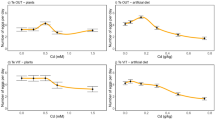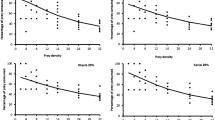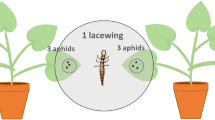Abstract
Phytoremediation has been proposed for the elimination of toxic metals in soil, yet little attention has been given to the performance of insects that feed on contaminant-tolerant plants. We tested the performance of two herbivores with different feeding behaviors, the cabbage looper, Trichoplusia ni, and the green peach aphid, Myzus persicae, reared on cadmium-tolerant Brassica juncea plants that contained different concentrations of cadmium. We also tested the performance of the aphid parasitoid Aphidius colemani developing in aphids reared on plants with different levels of cadmium. The hypothesis tested was that the chewing insect would be more negatively affected than the sucking insect, because of the localization of cadmium within the host plant, and that the aphid parasitoid would not be affected. We also compared the performance of T. ni on artificial diet with different levels of cadmium. Neither the phloem-feeding aphid nor its parasitoid was affected by cadmium in the host plant. The effects of cadmium on the foliage-feeding cabbage looper varied, with negative effects on development observed in experiments with artificial diet but not in those using natural host plants. These data, together with information available in the literature, support the idea that the effects of toxic metals present in a host plant may be influenced by a herbivore’s feeding strategy. However, a wide range of chewing and sucking species needs to be tested to confirm this hypothesis.



Similar content being viewed by others
References
Bahadorani, S. and Hilliker, A. J. 2009. Biological and behavioral effects of heavy metals in Drosophila melanogaster adults and larvae. J. Insect. Behav. 22:399–411.
Behmer, S., Lloyd, C., Raubenheimer, D., Stewart-Clark, J., Knight, J., Leighton, R., Harper, F., and Smith, J. 2005. Metal hyperaccumulation in plants: Mechanisms of defence against insect herbivores. Funct. Ecol. 19:55–66.
Borowska, J. and Pyza, E. 2011. Effects of heavy metals on insect immunocompetent cells. J. Insect Physiol. 57:760–770.
Boyd, R. 2004. Ecology of metal hyperaccumulation. New Phytol. 162:563–567.
Butler, C. D. and Trumble, J. T. 2008. Effects of pollutants on bottom-up and top-down processes in insect-plant interactions. Environ. Pollut. 156:1–10.
Calabrese, E. and Blain, R. 2005. The occurrence of hormetic dose responses in the toxicological literature, the hormesis database: An overview. Toxicol. Appl. Pharmacol. 202:289.
CANADIAN COUNCIL OF MINISTERS OF THE ENVIRONMENT (CCME). 2007. Canadian soil quality guidelines for the protection of environmental and human health www.ceqg-rcqe.ccme.ca (accessed Jan 13, 2013).
Chaney, R., Malik, M., Li, Y., Brown, S., Brewer, E., Angle, J., and Baker, A. 1997. Phytoremediation of soil metals. Curr. Opin. Biotechnol. 8:279–284.
Crawford, L., Hodkinson, I., and Lepp, N. 1995. The effects of elevated host-plant cadmium and copper on the performance of the aphid Aphis fabae (Homoptera: Aphididae). J. Appl. Ecol. 32:528–535.
Cui, Y., Fu, J., and Chen, X. 2011. Speciation and bioaccessibility of lead and cadmium in soil treated with metal-enriched Indian mustard leaves. J. Environmen. Sci.-China. 23:624–632.
Cunningham, S., Shann, J., Crowley, D., and Anderson, T. 1997. Phytoremediation of contaminated water and soil. Phytoremediation Soil Water Contam. 664:2–17.
Dmitriew, C. and Rowe, L. 2005. Resource limitation, predation risk and compensatory growth in a damselfly. Oecologia 142:150–154.
Filser, J., Wittmann, R., and Lang, A. 2000. Response types in Collembola towards copper in the microenvironment. Environ. Pollut. 107:71–78.
Freeman, J. L., Quinn, C. F., Marcus, M. A., Fakra, S., and Pilon-Smits, E. A. H. 2006. Selenium-tolerant diamondback moth disarms hyperaccumulator plant defense. Curr. Biol. 16:2181–2192.
Gadapati, W. R. and Macfie, S. M. 2006. The production of phytochelatins is only partially correlated with reduced Cd-stress in two species of Brassica. Plant. Sci. 170:471–480.
Gilbert, N. 1984. Control of fecundity in Pieris rapae I. The problem. J. Anim. Ecol. 53:581–588.
Gintenreiter, S., Ortel, J., and Nopp, H. 1993. Effects of different dietary levels of cadmium, lead, copper, and zinc on the vitality of the forest pest insect Lymantria dispar L (Lymantriidae, Lepidoptera). Arch. Environ. Contam. Toxicol. 25:62–66.
Gorur, G. 2006. Developmental instability in cabbage aphid (Brevicoryne brassicae) populations exposed to heavy metal accumulated host plants. Ecol. Indic. 6:743–748.
Gorur, G. 2007. Effects of host plant contaminated with heavy metals on the life history traits of aphids (brevicoryne brassicae L.). Pol. J. Ecol. 55:113–120.
Hanson, B., Garifullina, G., Lindblom, S., Wangeline, A., Ackley, A., Kramer, K., Norton, A., Lawrence, C., and Pilon-Smits, E. 2003. Selenium accumulation protects Brassica juncea from invertebrate herbivory and fungal infection. New Phytol. 159:461–469.
Honek, A., Dixon, A. F. G., and Martinkova, Z. 2008. Body size, reproductive allocation, and maximum reproductive rate of two species of aphidophagous Coccinellidae exploiting the same resource. Entomol. Exp. Appl. 127:1–9.
Ilijin, L., Peric-Mataruga, V., Radojicic, R., Lazarevic, J., Nenadovic, V., Vlahovic, M., and Mrdakovic, M. 2010. Effects of cadmium on protocerebral neurosecretory neurons and fitness components in Lymantria dispar L. Folia Biologica-Krakow. 58:91–99.
Jahangir, M., Abdel-Farid, I. B., Choi, Y. H., and Verpoorte, R. 2008. Metal ion-inducing metabolite accumulation in Brassica rapa. J. Plant Physiol. 165:1429–1437.
Janssens, T. K. S., Roelofs, D., and van Straalen, N. M. 2009. Molecular mechanisms of heavy metal tolerance and evolution in invertebrates. Insect Sci. 16:3–18.
Johnson, D. and Foulkers, E. 1980. On the proposed role of metallothionein in the transport of cadmium. Environ. Res. 21:360–365.
Kiss, T. and Osipenko, O. 1994. Toxic effects of heavy-metals on ionic channels. Pharmacol. Rev. 46:245–267.
Koricheva, J., Larsson, S., and Haukioja, E. 1998. Insect performance on experimentally stressed woody plants: A meta-analysis. Annu. Rev. Entomol. 43:195–216.
Kramarz, P. and Stark, J. 2003. Population level effects of cadmium and the insecticide imidacloprid to the parasitoid, Aphidius ervi after exposure through its host, the pea aphid, Acyrthosiphon pisum (Harris). Biol. Control. 27:310–314.
Kumar, P., Dushenkov, V., Motto, H., and Raskin, I. 1995. Phytoextraction—the use of plants to remove heavy-metals from soils. Environ. Sci. Technol. 29:1232–1238.
Larsen, K., Litsch, A., Brewer, S., and Taylor, D. 1994. Contrasting effects of sewage-sludge and commercial fertilizer on egg to adult development of 2 herbivorous insect species. Ecotoxicology 3:94–109.
Lauverjat, S., Ballan-Duferancais, C., and Wegnez, M. 1989. Detoxification of cadmium. Ultrastructural study and electron-probe microanalysis of the midgut in cadmium- resistantstrain Drosophila melanogaster. Biol. Metals. 2:97–107.
Merrington, G., Miller, D., McLaughlin, M., and Keller, M. 2001. Trophic barriers to fertilizer Cd bioaccumulation through the food chain: A case study using a plant-insect predator pathway. Arch. Environ. Contam. Toxicol. 41:151–156.
Mesjasz-Przybylowicz, J. and Przybylowicz, W. J. 2011. PIXE and metal hyperaccumulation: From soil to plants and insects. X-Ray Spectrom. 40:181–185.
Migula, P., Przybylowicz, W. J., Mesjasz-Przybylowicz, J., Augustyniak, M., Nakonieczny, M., Glowacka, E., and Tarnawska, M. 2007. Micro-PIXE studies of elemental distribution in sap-feeding insects associated with Ni hyperaccumulator, Berkheya coddii. Plant Soil 293:197–207.
Mircic, D., Jankovic-Tomanic, M., Nenadovic, V., Franeta, F., and Lazarevic, J. 2010. The effects of cadmium on the life history traits of Lymantria dispar L. Arch. Biol. Sci. 62:1013–1020.
Mogren, C. L. and Trumble, J. T. 2010. The impacts of metals and metalloids on insect behavior. Entomol. Exp. Appl. 135:1–17.
Muller, C. and Arand, K. 2007. Trade-offs in oviposition choice? Food-dependent performance and defence against predators of a herbivorous sawfly. Entomol. Exp. Appl. 124:153–159.
Nascarella, M., Stoffolano, J., Stanek, E., Kostecki, P., and Calabrese, E. 2003. Hormesis and stage specific toxicity induced by cadmium in an insect model, the queen blowfly, Phormia regina Meig. Environ. Pollut. 124:257–262.
Nordberg, G. F. 2009. Historical perspectives on cadmium toxicology. Toxicol. Appl. Pharmacol. 238:192–200.
Prasad, M. 1995. Cadmium toxicity and tolerance in vascular plants. Environ. Exp. Bot. 35:525–545.
Popham, H. J. R., Shelby, K. S., and Popham, T. W. 2005. Effect of dietary selenium supplementation on resistance to baculovirus infection. Biol. Control. 32:419–426.
Quimby, P., Frick, K., Wauchope, R., and Kay, S. 1979. Effects of cadmium on 2 biocontrol insects and their host weeds. Bull. Environ. Contam. Toxicol. 22:371–378.
Salt, D. E., Prince, R. C., Pickering, I. J., and Raskin, I. 1995. Mechanisms of cadmium mobility and accumulation in Indian mustard. Plant Physiol. 109:1427–1433.
Shorey, H. and Hale, R. 1965. Mass-rearing of the larvae of nine noctuid species on a simple artificial medium. J. Econ. Entomol. 58:522524.
Trumble, J. and Jensen, P. 2004. Ovipositional response, developmental effects and toxicity of hexavalent chromium to Megaselia scalaris, a terrestrial detritivore. Arch. Environ. Contam. Toxicol. 46:372–376.
US EPA (United States Environmental Protection Agency), 2005. Test methods for evaluating solid waste, physical/chemical methods, series 3000. [Online] Available: http://www.epa.gov/epaoswer/hazwaste/test/main.htm/ (accessed Jan 20, 2012)
van Ooik, T., Rantala, M. J., and Saloniemi, I. 2007. Diet-mediated effects of heavy metal pollution on growth and immune response in the geometrid moth Epirrita autumnata. Environ. Pollut. 145:348–354.
Vickerman, D., Young, J., and Trumble, J. 2002. Effect of selenium-treated alfalfa on development, survival, feeding, and oviposition preferences of Spodoptera exigua (Lepidoptera: Noctuidae). Environ. Entomol. 31:953–959.
Vickerman, D. and Trumble, J. 2003. Biotransfer of selenium: Effects on the insect predator. Podisus maculiventris, Ecotoxicol. 12:497–504.
Zhang, Z., Lu, X., Wang, Q., and Zheng, D. 2009. Mercury, cadmium and lead biogeochemistry in the soil-plant-insect system in Huludao city. Bull. Environ. Contam. Toxicol. 83:255–259.
Zhuang, P., Zou, H., and Shu, W. 2009. Biotransfer of heavy metals along a soil-plant-insect-chicken food chain: Field study. J. Environ. Sci. (China) 21:849–853.
Author information
Authors and Affiliations
Corresponding author
Rights and permissions
About this article
Cite this article
Konopka, J.K., Hanyu, K., Macfie, S.M. et al. Does the Response of Insect Herbivores to Cadmium Depend on Their Feeding Strategy?. J Chem Ecol 39, 546–554 (2013). https://doi.org/10.1007/s10886-013-0273-4
Received:
Revised:
Accepted:
Published:
Issue Date:
DOI: https://doi.org/10.1007/s10886-013-0273-4




